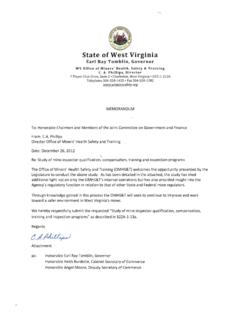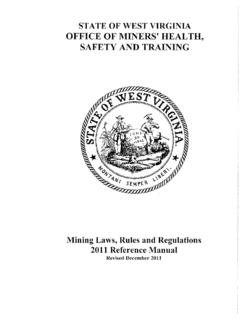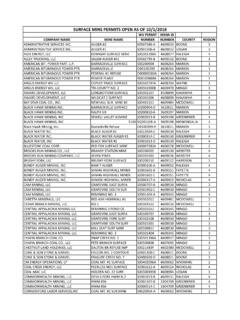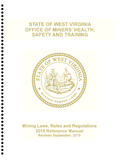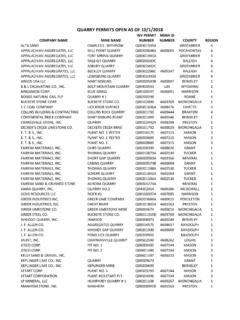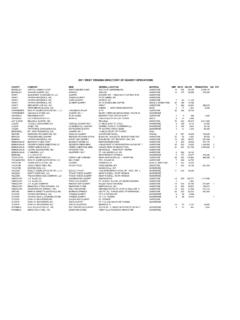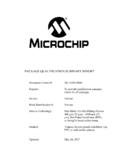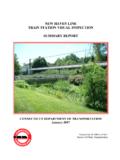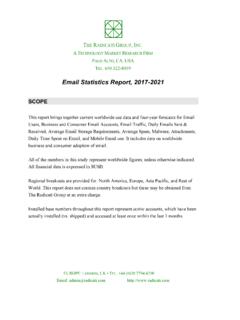Transcription of Upper Big Branch Mine Disaster Investigative Report Summary
1 Upper Big Branch Mine Disaster Investigative ReportSummaryWest Virginia Office of Miners Health, Safety and Trainingreport SummaryOn April 5, 2010, at approximately 3:02 , an explosion ripped through the underground workings at Performance Coal Company, UBBMC, Montcoal Eagle Mine (UBB), taking the lives of 29 miners and injuring two others. The explosion began after gas, mostly methane, was ignited by frictional impact as the shearer was cutting sandstone roof or by the rock colliding with steel supports or other rock while falling from the sandstone roof behind the longwall shields. It is deemed more likely that the longwall mining machine (shearer) ignited the methane gas apparently was liberated from the mine floor behind the roof-supporting longwall shields, and, as this gas flowed to the return behind the shields, the airflow then became restricted by a recent roof fall across the #7 entry of the #21 Tailgate. This may have allowed combustible gas to accumulate near the location where the shearer was operating.
2 This roof fall would not allow the air current to move directly toward the return at the tailgate corner of the gob, causing it to flow outby to an open crosscut. The shearer shut down just a few feet short of its normal stop position as it mined into the tailgate entry. Approximately 1 minutes later an explosion occurred in the gob behind the longwall shields, spreading quickly to the #21 Tailgate and from there propagated through an extensive area of the mine. This accumulation of methane was not detected by the required mine examinations or by the required machine-mounted methane monitors. The methane explosion quickly transitioned into a coal dust explosion, which severely damaged ventilation controls, conveyor belts, water lines, electrical systems and numerous items in its path until the fuel was consumed and the explosion extinguished itself outby the track switch at the beginning of North Glory Mains. Part of our investigation involved examining the sources of fine coal dust, both float dust from mining sections and conveyor belts, as well as sloughed material from friable coal ribs.
3 We find that fine accumulations that can easily be dispersed into the air by the pressure wave ahead of a propagating flame are of primary concern and deserve increased attention. The amount of rock dust being maintained on mine surfaces at the time of the explosion was insufficient to stop a coal dust explosion. The region where the dust explosion started does not appear to have had rock dust periodically applied over the fine coal dust. Periodic applications of rock dust over accumulating fine coal dust are necessary to render such dust greatest defense against the hazards of fine coal dust is the proper application of rock dust. The way we currently sample and apply rock dust needs to be modernized, using the latest research knowledge and most appropriate sampling and analyzing methods available. Other strategies to arrest a dust explosion include explosion mitigation barriers, which have important applications in certain conditions. Investigators found evidence that a water barrier just west of #22 Cross-over stopped the explosion from propagating further inby in the #21 Headgate entries.
4 Further research is needed to demonstrate the practical application of water barriers, rock rubble barriers and other explosion-mitigating strategies as supplemental protection with generalized rock dusting to prevent explosion propagations in the future. The data combined in the full Report will serve as a resource for future ) The explosion at the Upper Big Branch Mine on Monday, April 5, 2010, occurred at approximately 3:02 The explosion was the result of methane accumulating in the #21 Longwall Tailgate T-split area and in the gob behind the longwall shields, which was then ) There are two possibilities for the ignition. It is possible that sandstone roof rock falling behind the longwall shields ignited gas by rock-on-rock impact or rock-on-steel impact. However, the more likely cause is that it occurred on the longwall as the shearer was cutting sandstone roof, igniting gas by steel-on-rock impact along the shearer bits producing hot smears as it cut sandstone roof.
5 3) Approximately 90 seconds elapsed from the time the shearer was de-energized until the time of the explosion. 4) The actual explosion most likely began in the gob behind the longwall shields, between shield 173 and shield 117. Explosion forces propagated along a flammable gas fringe behind the shields north to approximately shield 65 to 55, where access to fuel and space were restricted and the forces were diverted into the longwall where they subsided to extinction. Explosion forces also propagated west/southwest through the gob, exiting the gob 300 to 400 feet west of the longwall shearer. Additionally, explosion forces from the gob propagated south/southeast entering the longwall a short distance north of the shearer and traveled across the shearer as it exited the longwall and entered the #7 entry of the #21 Tailgate. From these two locations in the #21 Tailgate, the explosion transitioned into a coal dust explosion which continued propagating east and west and throughout an extensive area of the mine.
6 5) Coal float dust, combined with fine coal dust derived from rib spalling, is believed to be the principle source of fuel for the propagating ) An airflow restriction, approximately 45 feet inby the shearer in the #7 entry of #21 Tailgate, caused by roof caving associated with the advancing longwall would have allowed any gas migration into that location to build up. A small amount of air could move over and around the fall, but the majority of the air did ) Methane, mixed with other gases, is emanating from a source beneath the mine floor. A combination of overburden cover depth, mine floor rock strength, and local fracturing (natural and induced) influence where connecting pathways to gas are intercepted during mining. Prior gas events and the April 5, 2010, explosion appears correlated with local thickening of an underlying coal seam located 10 to 15 feet ) The removal of hazards and violations identified during required mine examinations were not corrected in a timely ) There was no indication that the #21 Tailgate entries west of the #21 Cross-over had been rock dusted since the Longwall began production in September 2009.
7 Based on testimony and available information there is no evidence that additional rock dust was applied after initial development throughout this extensive Explosion Defenses1) The lines of defense to eliminate mine explosions are adequate ventilation, detection of explosive gases, removal of ignition sources, cleanup of fine coal dust accumulations and rock dusting. In other words:a) prevent methane accumulations or find the accumulation before it becomes a problem. b) prevent the ignition if an accumulation occurs undetected. c) prevent a coal dust explosion if an undetected accumulation of methane becomes these defense mechanisms failed at UBB. Additional defenses are needed to prevent propagation of a methane explosion into a coal dust explosion. Explosion barriers have been studied for years and have been found to be effective in stopping an explosion. Investigators found evidence that a water barrier just west of #22 Cross-over stopped the explosion from propagating further inby in the #21 Headgate entries.
8 The first arrival of explosion forces entered through a water-filled dip and then passed over a gob pile which reduced the opening height to about 4 feet. The result was recorded by impacted mud deposits, instead of impacted dust, and by the rapid decay in heat and pressure forces inby. The explosion subsided to extinction between breaks 31 and 35 of #21 Headgate, and further evidence of an explosion was not found as far west as could be safely traveled and is needed to demonstrate the practical application of water barriers, rock rubble barriers and other explosion mitigation strategies as supplemental protection, with generalized rock dusting, to prevent explosion propagations. It is recommended that NIOSH renew their research into the subject of barriers and develop systems that can be used in operating coal Systems1) WVOMHS&T currently has insufficient statutory language to regulate the way that coal mines are ventilated. 2) Coal operators must take a more proactive approach to the ventilation of each coal mine under their authority and responsibility.
9 The industry has taken a step back over the years in proper planning and preparation as long-term plans are developed. The operator must once again lead the way in doing the hard and extensive work necessary to properly ventilate each mine. Registered Professional Engineers can help bridge the gap between prudent planning and maintenance of mine ventilation. Mine managers and regulators must allow the Professional Engineer to do his/her job and should not be so quick to disregard the engineer s professional judgment, which he/she is charged by charter to do in order to protect public safety. 3) A closer look must be taken concerning the use of belt air during longwall mining to assure that the most effective means are being utilized to maximize ventilation to the longwall face and the active gob areas including the tailgate T-Split ( , where the longwall face intersects its principle return air course). 4) The T-split is a critical location where longwall ventilation can become blocked, which is what happened at UBB.
10 Additional measures to support the roof at this location are prudent and recommended. Many operators are already doing this. In addition, should the T-split become blocked, there should be supplemental precautionary measures that are initiated to ensure the ventilation system is keeping gas mixtures properly diluted. 5) The excessive use of airlock doors along the ventilating current must be minimized to assure that ventilation is not compromised. Although this is currently addressed in the West Virginia Code, it requires clarification with stricter guidelines for enforcement. 6) Critical air splits in the mine should be adequately monitored at strategic locations to give warning of unusual or dangerous amounts of methane, carbon monoxide or other harmful gases. This system should alert the operator if an air reversal or a drastic change occurs in the ventilating air volumes. These devices should give warning to a central location on the surface so workers in the affected areas can be alerted to hazardous conditions.
